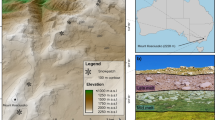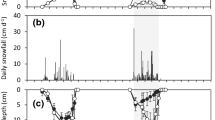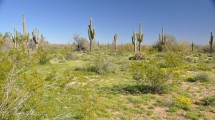Abstract
Alpine plant communities are predicted to face range shifts and possibly extinctions with climate change. Fine-scale environmental variation such as nutrient availability or snowmelt timing may contribute to the ability of plant species to persist locally; however, variation in nutrient availability in alpine landscapes is largely unmeasured. On three mountains around Davos, Switzerland, we deployed Plant Root Simulator probes around 58 Salix herbacea plants along an elevational and microhabitat gradient to measure nutrient availability during the first 5 weeks of the summer growing season, and used in situ temperature loggers and observational data to determine date of spring snowmelt. We also visited the plants weekly to assess performance, as measured by stem number, fruiting, and herbivory damage. We found a wide snowmelt gradient which determined growing season length, as well as variations of an order of magnitude or more in the accumulation of 12 nutrients between different microhabitats. Higher nutrient availability had negative effects on most shrub performance metrics, for instance decreasing stem number and the proportion of stems producing fruits. High nutrient availability was associated with increased herbivory damage in early-melting microhabitats, but among late-emerging plants this pattern was reversed. We demonstrate that nutrient availability is highly variable in alpine settings, and that it strongly influences performance in an alpine dwarf shrub, sometimes modifying the response of shrubs to snowmelt timing. As the climate warms and human-induced nitrogen deposition continues in the Alps, these factors may contribute to patterns of local plants persistence.




Similar content being viewed by others
References
Alsos IG, Alm T, Normand S, Brochmann C (2009) Past and future range shifts and loss of diversity in dwarf willow (Salix herbacea L.) inferred from genetics, fossils and modelling. Glob Ecol Biogeogr 18:223–239. doi:10.1111/j.1466-8238.2008.00439.x
Bakkenes M, Alkemade JRM, Ihle F et al (2002) Assessing effects of forecasted climate change on the diversity and distribution of European higher plants for 2050. Glob Change Biol 8:390–407. doi:10.1046/j.1354-1013.2001.00467.x
Bengtson P, Basiliko N, Prescott CE, Grayston SJ (2007) Spatial dependency of soil nutrient availability and microbial properties in a mixed forest of Tsuga heterophylla and Pseudotsuga menziesii, in coastal British Columbia, Canada. Soil Biol Biochem 39:2429–2435. doi:10.1016/j.soilbio.2007.04.010
Bergmann S (2013) Experimental warming increased insect herbivory in an alpine dryas heath at Finse, Norway. Master thesis, Department of Ecology and Natural Resource Management, Norwegian University of Life Sciences, Ås
Bliss LC (1966) Plant productivity in alpine microenvironments on Mt. Washington, New Hampshire. Ecol Monogr 36:125–155. doi:10.2307/1942152
Bowman WD, Theodose TA, Schardt JC, Conant RT (1993) Constraints of nutrient availability on primary production in two alpine tundra communities. Ecology 74:2085–2097. doi:10.2307/1940854
Bowman WD, Bahn L, Damm M (2003) Alpine landscape variation in foliar nitrogen and phosphorus concentrations and the relation to soil nitrogen and phosphorus availability. Arct Antarct Alp Res 35:144–149. doi:10.1657/1523-0430(2003)035[0144:ALVIFN]2.0.CO;2
Campbell D, Halama KJ (1993) Resource and pollen limitations to lifetime seed production in a natural plant population. Ecology 74:1043–1051. doi:10.2307/1940474
Carbognani M, Petraglia A, Tomaselli M (2012) Influence of snowmelt time on species richness, density and production in a late snowbed community. Acta Oecol 43:113–120. doi:10.1016/j.actao.2012.06.003
Chapin FS III (1980) The mineral nutrition of wild plants. Annu Rev Ecol Syst 11:233–260. doi:10.1146/annurev.es.11.110180.001313
Choler P (2005) Consistent shifts in alpine plant traits along a mesotopographical gradient. Arct Antarct Alp Res 37:444–453. doi:10.1657/1523-0430(2005)037[0444:CSIAPT]2.0.CO;2
Choler P, Michalet R, Callaway RM (2001) Facilitation and competition on gradients in alpine plant communities. Ecology 82:3295–3308
Clemmensen KE, Michelsen A (2006) Integrated long-term responses of an arctic–alpine willow and associated ectomycorrhizal fungi to an altered environment. Can J Bot 843:831–843. doi:10.1139/B06-039
Crase B, Liedloff A, Vesk PA et al (2014) Incorporating spatial autocorrelation into species distribution models alters forecasts of climate-mediated range shifts. Glob Change Biol 20:2566–2579. doi:10.1111/gcb.12598
Dinno A (2012) paran: Horn’s test of principal components/factors. R Foundation for Statistical Computing, Vienna. http://CRAN.R-project.org/package=paran
Edwards AC, Scalenghe R, Freppaz M (2007) Changes in the seasonal snow cover of alpine regions and its effect on soil processes: a review. Quat Int 162–163:172–181. doi:10.1016/j.quaint.2006.10.027
Fisk MC, Schmidt SK, Seastedt TR (1998) Topographic patterns of above- and belowground production and nitrogen cycling in alpine tundra. Ecology 79:2253–2266. doi:10.1890/0012-9658(1998)079[2253:TPOAAB]2.0.CO;2
Galen C, Stanton ML (1993) Short-term responses of alpine buttercups to experimental manipulations of growing season length. Ecology 74:1052–1058. doi:10.2307/1940475
Gerdol R, Siffi C, Iacumin P et al (2013) Advanced snowmelt affects vegetative growth and sexual reproduction of Vaccinium myrtillus in a sub-alpine heath. J Veg Sci 24:569–579. doi:10.1111/j.1654-1103.2012.01472.x
Guisan A, Theurillat J (2000) Assessing alpine plant vulnerability to climate change: a modeling perspective. Integr Assess 1:307–320. doi:10.1023/A:1018912114948
Häggberg S (2013) Genet size in dwarf willow (Salix herbacea L.). Master thesis, Department of ecology and genetics, Uppsala University, Uppsala
Hairston NG, Smith FE, Slobodkin LB (1960) Community structure, population control, and competition. Am Nat 94:421–425. doi:10.1086/282146
Hansen AH, Jonasson S, Michelsen A, Julkunen-Tiitto R (2006) Long-term experimental warming, shading and nutrient addition affect the concentration of phenolic compounds in arctic-alpine deciduous and evergreen dwarf shrubs. Oecologia 147:1–11. doi:10.1007/s00442-005-0233-y
Huntly N (1991) Herbivores and the dynamics of communities and ecosystems. Annu Rev Ecol Syst 22:477–503. doi:10.1146/annurev.es.22.110191.002401
Inouye D (2008) Effects of climate change on phenology, frost damage, and floral abundance of montane wildflowers. Ecology 89:353–362. doi:10.1890/06-2128.1
IPCC (2013) Climate Change 2013. The physical science basis, working group I; contribution to the fifth assessment report of the intergovernmental panel on climate change, summary for policymakers. Available at: https://www.ipcc.ch/report/ar5/wg1/docs/ WGIAR5_SPM_brochure_en.pdf 10.1017/CBO9781107415324.004
Jacobs JD, Chan S, Sutton E (2014) Climatology of the forest-tundra ecotone at a maritime subarctic-alpine site, Mealy Mountains, Labrador. Arctic 67:28–42. doi:10.14430/arctic4358
Johnson DW, Verburg PSJ, Arnone JA (2005) Soil extraction, ion exchange resin, and ion exchange membrane measures of soil mineral nitrogen during incubation of a tallgrass prairie soil. Soil Sci Soc Am J 69:260. doi:10.2136/sssaj2005.0260
Körner C (1989) The nutritional status of plants from high altitudes. Oecologia 81:379–391. doi:10.1007/BF00377088
Kudo G (1993) Relationships between flowering time and fruit set of the entomophilous alpine shrub, Rhododendron aureum (Ericaceae), inhabiting snow patches. Am J Bot 80:1300–1304. doi:10.1657/1938-4246-46.3.548
Kudo G, Hirao AS (2005) Habitat-specific responses in the flowering phenology and seed set of alpine plants to climate variation: implications for global-change impacts. Popul Ecol 48:49–58. doi:10.1007/s10144-005-0242-z
Kusbach A, Van Miegroet H (2013) Nutrient availability assessment method in semiarid ecosystems in the central Rocky Mountains, Utah. Soil Sci Soc Am J 77:1057. doi:10.2136/sssaj2012.0432n
Litaor MI, Seastedt TR, Walker MD et al (2005) The biogeochemistry of phosphorus across an alpine topographic/snow gradient. Geoderma 124:49–61. doi:10.1016/j.geoderma.2004.04.001
Michalet R, Gandoy C, Joud D et al (2002) Plant community composition and biomass on calcareous and silicaceous substrates in the northern French Alps: comparative effects of soil chemistry and water status. Arct Antarct Alp Res 34:102–113. doi:10.2307/1552514
Moser D, Dullinger S, Englisch T et al (2005) Environmental determinants of vascular plant species richness in the Austrian Alps. J Biogeogr 32:1117–1127. doi:10.1111/j.1365-2699.2005.01265.x
Muñoz AA, Celedon-Neghme C, Cavieres LA, Arroyo MTK (2005) Bottom-up effects of nutrient availability on flower production, pollinator visitation, and seed output in a high-Andean shrub. Oecologia 143:126–135. doi:10.1007/s00442-004-1780-3
Nussbaumer A (2012) Neighbour interactions of an alpine dwarf shrub (Salix herbacea L.) and its Influence on Biodiversity. Master thesis, Institute of Geography, University of Zurich, Zurich
Petraglia A, Carbognani M, Tomaselli M (2013) Effects of nutrient amendments on modular growth, flowering effort and reproduction of snowbed plants. Plant Ecol Divers 6:475–486. doi:10.1080/17550874.2013.795628
Pinheiro J, Bates D, DebRoy S et al (2013) nlme: linear and nonlinear mixed effects models. R Foundation for Statistical Computing, Vienna. http://cran.r-project.org/package=nlme
R Development Core Team (2014) R: a language and environment for statistical computing. R Foundation for Statistical Computing, Vienna. http://www.r-project.org
Randin CF, Engler R, Normand S et al (2009) Climate change and plant distribution: local models predict high-elevation persistence. Glob Change Biol 15:1557–1569. doi:10.1111/j.1365-2486.2008.01766.x
Reich PB, Wright IJ, Cavender-Bares J et al (2003) The evolution of plant functional variation: traits, spectra, and strategies. Int J Plant Sci 164:S143–S164. doi:10.1086/374368
Rogora M, Mosello R, Arisci S et al (2006) An overview of atmospheric deposition chemistry over the Alps: present status and long-term trends. Hydrobiologia 562:17–40. doi:10.1007/s10750-005-1803-z
Roy B, Gusewell S, Harte J (2004) Response of plant pathogens and herbivores to a warming experiment. Ecology 85:2570–2581. doi:10.1890/03-0182
Rustad ALE, Campbell JL, Marion GM et al (2001) A meta-analysis of the response of soil respiration, net nitrogen mineralization, and aboveground plant growth to experimental ecosystem warming. Oecologia 126:543–562. doi:10.1007/S004420000544
Scherrer D, Körner C (2011) Topographically controlled thermal-habitat differentiation buffers alpine plant diversity against climate warming. J Biogeogr 38:406–416. doi:10.1111/j.1365-2699.2010.02407.x
Schöb C, Kammer PM, Kikvidze Z et al (2010) Counterbalancing effects of competition for resources and facilitation against grazing in alpine snowbed communities. Oikos 119:1571–1580. doi:10.1111/j.1600-0706.2010.18288.x
Scott D, Billings WD (1964) Effects of environmental factors on standing crop and productivity of an alpine tundra. Ecol Monogr 34:243–270. doi:10.2307/1948502
Seastedt TR, Vaccaro L (2001) Plant species richness, productivity, and nitrogen and phosphorus limitations across a snowpack gradient in alpine tundra, Colorado, USA. Arct Antarct Alp Res 33:100–106. doi:10.2307/1552283
Sedlacek JF, Bossdorf O, Cortés AJ et al (2014) What role do plant-soil interactions play in the habitat suitability and potential range expansion of the alpine dwarf shrub Salix herbacea? Basic Appl Ecol 15:305–315. doi:10.1016/j.baae.2014.05.006
Sedlacek JF, Wheeler JA, Cortés AJ et al (2015) The response of the alpine dwarf shrub Salix herbacea to altered snowmelt timing: lessons from a multi-site transplant experiment. PLoS ONE 10:e0122395. doi:10.1371/journal.pone.0122395
Smith JG, Sconiers W, Spasojevic MJ et al (2012) Phenological changes in alpine plants in response to increased snowpack, temperature, and nitrogen. Arct Antarct Alp Res 44:135–142. doi:10.1657/1938-4246-44.1.135
Stanton ML, Rejmánek M, Galen C (1994) Changes in vegetation and soil fertility along a predictable snowmelt gradient in the mosquito range, Colorado, USA. Arct Alp Res 26:364–374. doi:10.2307/1551798
Stein A, Gerstner K, Kreft H (2014) Environmental heterogeneity as a universal driver of species richness across taxa, biomes and spatial scales. Ecol Lett 17:866–880. doi:10.1111/ele.12277
Thuiller W, Lavorel S, Araújo MB et al (2005) Climate change threats to plant diversity in Europe. Proc Natl Acad Sci USA 102:8245–8250. doi:10.1073/pnas.0409902102
Walker MD, Ingersoll RC, Webber PJ (1995) Effects of interannual climate variation on phenology and growth of two alpine forbs. Ecology 76:1067–1083. doi:10.2307/1940916
Wheeler JA, Hermanutz L, Marino PM (2011) Feathermoss seedbeds facilitate black spruce seedling recruitment in the forest–tundra ecotone (Labrador, Canada). Oikos 120:1263–1271
Wheeler JA, Hoch G, Cortés AJ et al (2014) Increased spring freezing vulnerability for alpine shrubs under early snowmelt. Oecologia 175:219–229. doi:10.1007/s00442-013-2872-8
Wheeler JA, Schnider F, Sedlacek J et al (2015) With a little help from my friends: community facilitation increases performance in the dwarf shrub Salix herbacea. Basic Appl Ecol. doi:10.1016/j.baae.2015.02.004
Wipf S (2010) Phenology, growth, and fecundity of eight subarctic tundra species in response to snowmelt manipulations. Plant Ecol 207:53–66. doi:10.1007/s11258-009-9653-9
Wipf S, Stoeckli V, Bebi P (2009) Winter climate change in alpine tundra: plant responses to changes in snow depth and snowmelt timing. Clim Change 94:105–121. doi:10.1007/s10584-009-9546-x
Wookey PA, Parsons AN, Welker JM et al (1993) Comparative responses of phenology and reproductive development to simulated environmental change in sub-arctic and high arctic plants. Oikos 67:490–502. doi:10.2307/3545361
Acknowledgments
The authors are indebted to their 2013 field staff, including Günther Klonner, Sofia Häggberg, and Flurina Schnider. We would also like to thank Dr. Sophie Karrenberg and Dr. Sonja Wipf for invaluable comments which greatly improved this manuscript. This project was made possible by funding from the Swiss National Science Foundation (grant CRSI33_130409/1). CJL would also like to thank the Erasmus Mundus Master Programme in Evolutionary Biology for scholarship funding, and Dr. Herwig Stibor of the Ludwig Maximilians University for co-supervision of this research. The authors would like to dedicate this paper to our late colleague and friend, Janosch Sedlacek.
Author contribution statement
CR, JAW, JS, and AJC conceived and designed the experiment. CJL, JS and JAW performed the fieldwork. AJC, JAW, CJL and JS carried out data extraction. CJL performed labwork and statistical analysis. CJL wrote the manuscript. JAW, CR, JS and AJC reviewed and commented on the manuscript. The authors declare they have no conflict of interest and that all experiments comply with the current laws of Switzerland.
Author information
Authors and Affiliations
Corresponding author
Additional information
Communicated by Hermann Heilmeier.
This study examines how fine-scale variation in the interactions among nutrient availability, snowmelt timing, soil moisture, and other abiotic factors are distributed throughout a Swiss alpine landscape. Unlike many previous studies that have used single-factor approaches to assess spatial variation in nutrient availability, we used a multivariate, integrative technique that includes the effects of soil moisture on nutrient uptake. Using this approach, we show that microhabitats can vary as much over 30 to 40 meters as they do from the top to bottom of kilometer-long elevational transects.
Electronic supplementary material
Below is the link to the electronic supplementary material.
Rights and permissions
About this article
Cite this article
Little, C.J., Wheeler, J.A., Sedlacek, J. et al. Small-scale drivers: the importance of nutrient availability and snowmelt timing on performance of the alpine shrub Salix herbacea . Oecologia 180, 1015–1024 (2016). https://doi.org/10.1007/s00442-015-3394-3
Received:
Accepted:
Published:
Issue Date:
DOI: https://doi.org/10.1007/s00442-015-3394-3




